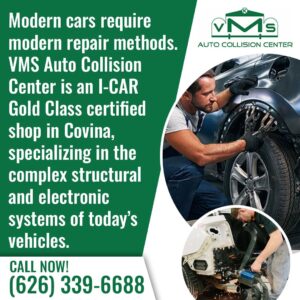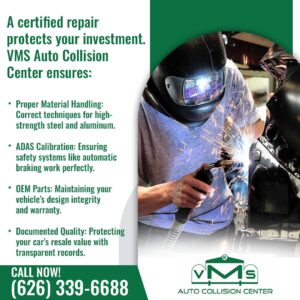Proper automotive collision repair directly impacts two critical aspects of vehicle ownership: occupant safety and financial investment protection. Substandard repairs compromise safety systems, structural integrity, and can reduce resale value when compared to properly restored vehicles. At VMS Auto Collision Center, our I-CAR Gold Class certified technicians follow manufacturer specifications to restore both safety performance and market value after every collision repair.
The difference between amateur work and professional restoration becomes apparent in crash test performance, system functionality, and resale appraisals. Modern vehicles contain safety technology that requires precise calibration and structural repairs that meet engineering specifications. When these systems fail or structures weaken due to improper repairs, the consequences affect both immediate protection and long-term financial returns.

The Complexity of Modern Vehicle Collision Repair
Vehicle construction has transformed over the past decade. Today’s automobiles integrate complex materials, electronic systems, and safety features that require specialized knowledge to repair correctly. This evolution makes the selection of a qualified auto collision shop more critical.
Material Science Changes Body Repair Requirements
Modern vehicles are built using multiple material types within a single structure. It combines traditional steel with high-strength steel alloys, aluminum panels, carbon fiber components, and advanced plastics. Each material responds differently to impact forces and demands specific repair techniques. Standard welding equipment and procedures that work for conventional steel can damage or weaken high-strength materials.
The automotive industry adopted these mixed-material designs to improve fuel efficiency while maintaining crash protection. Lighter materials reduce vehicle weight, but their repair requires investment in specialized tools and training. VMS Auto Collision Center maintains equipment for working with all current automotive materials, allowing us to handle collision repair on vehicles ranging from economy models to luxury brands without compromising structural integrity.
Electronic Integration Creates New Repair Challenges
The average new car contains over 100 million lines of software code controlling everything from engine performance to safety systems. Collision damage can disrupt these electronic networks even when physical damage appears minor. Sensors, wiring harnesses, and control modules located throughout the body structure become vulnerable during impacts.
Professional shops perform diagnostic scans of all vehicle systems before and after repairs. This testing identifies damage invisible during physical inspection alone. Technicians retrieve fault codes from engine, transmission, ABS, airbag, and ADAS modules that reveal which systems sustained damage. After repairing or replacing affected components, qualified shops verify proper system communication through post-repair scanning. This thorough diagnostic approach prevents future problems that could compromise safety or create frustrating malfunctions months after the initial repair.
Safety System Evolution Demands Expertise
Vehicle safety technology advances faster than most owners realize. Lane keeping assist, automatic emergency braking, blind spot monitoring, and adaptive cruise control all rely on precise sensor positioning and calibration. These systems require recalibration after any repair work near sensor locations, even when sensors themselves remain undamaged.
Even a misalignment of less than one degree can cause sensor malfunctions. A radar unit positioned just one degree off-axis can misinterpret vehicle speeds and distances, causing false warnings or preventing system activation when needed.
The Connection Between Repair Quality and Long-Term Vehicle Value
Purchase price represents just the beginning of vehicle ownership costs. Collision repair quality directly influences depreciation rates and resale values in ways many owners don’t consider until selling time arrives.
How Repair Documentation Affects Market Perception
Vehicle history reports have become standard tools for used car buyers. Services like CARFAX and AutoCheck compile accident reports, insurance claims, and repair records into accessible histories. Vehicles with a history of accidents experience a resale value reduction compared to similar vehicles with clean titles.
The extent of reduction can vary based on the severity of the accident, nature of the repairs, and the vehicle’s age or category. Repaired vehicles tend to be valued lower in the used market due to buyer concerns and diminished value assessments. But proper repair documentation can minimize this value gap.
Detailed repair records demonstrating professional work help overcome buyer skepticism. Documentation showing manufacturer-approved procedures, quality parts usage, and certified technician involvement provides evidence that repairs restored the vehicle properly. At VMS Auto Collision Center, we provide customers with complete repair documentation, including photos, parts lists, and procedure verification, which becomes valuable when selling or trading vehicles.
Material Degradation From Improper Repairs
Poor repair work initiates degradation processes that worsen over time. Improperly mixed paint begins fading within months as UV protection breaks down. Incorrect body filler application traps moisture that causes rust beneath seemingly solid surfaces. These problems emerge gradually, often becoming noticeable just as owners prepare vehicles for sale.
Professional paint application includes proper surface preparation, appropriate primer selection, accurate color matching, and correct clear coat thickness. Quality auto collision shops use climate-controlled paint booths and computerized color-matching systems to eliminate variables that lead to premature paint failure. Skilled technicians limit body filler use to appropriate situations and maintain proper application techniques that prevent future problems.
Preventing Corrosion During Collision Repairs
Automotive collision damage often compromises factory corrosion protection. Paint scratches, metal deformation, and exposed edges all create entry points for moisture and road salt. Professional repairs restore corrosion protection through proper preparation, appropriate primers, and complete sealing of vulnerable areas.
California’s coastal areas expose vehicles to salt air that accelerates corrosion in unprotected metal. Inland areas also face corrosion risks from winter road treatments and environmental factors. Certified shops include corrosion protection measures at multiple repair stages. Technicians treat bare metal with appropriate primers, seal panel joints to prevent moisture intrusion, and apply protective coatings to vulnerable areas. These preventive steps provide long-term protection that maintains vehicle condition and value.
Why Shortcuts in Automotive Collision Repair Create Long-Term Problems
Cost pressures tempt some shops to reduce collision repair quality through shortcuts that save time and money. These compromises may not appear obvious at vehicle pickup but reveal themselves through premature failures and safety concerns.
The True Cost of Aftermarket and Salvage Parts
Parts selection represents one area where shops compromise quality to reduce costs. Aftermarket parts from unknown manufacturers may fit poorly, lack proper corrosion protection, or use inferior materials. Salvage parts removed from other vehicles carry an unknown history and potential hidden damage that leads to premature failure.
OEM (Original Equipment Manufacturer) components undergo extensive testing, match factory specifications exactly, and maintain vehicle warranty coverage. At VMS Auto Collision Center, we discuss parts options with customers and explain the differences between OEM, quality aftermarket, and salvage components. Our recommendations prioritize safety and longevity while respecting budget constraints.
Missing Calibration Steps After Repairs
Safety system calibration represents a frequently skipped step at shops lacking proper equipment or training. These systems may appear functional without calibration but operate outside specification ranges. Uncalibrated ADAS features might activate late, fail to engage, or trigger false warnings that cause drivers to disable systems entirely.
Calibration procedures vary by manufacturer and model year. Some systems require static calibration using specific targets positioned at precise distances and heights in controlled environments. Others need dynamic calibration performed while driving vehicles in specific patterns at controlled speeds. Both approaches demand specialized equipment that can cost tens of thousands of dollars, which explains why some shops skip this critical step.
VMS Auto Collision Center: Protecting Safety and Resale Value Through Excellence
Our repair philosophy balances technical excellence with customer service to deliver results that meet the highest industry standards. This approach evolved through 35 years of serving Covina area customers and adapting to advancing vehicle technology.
Family Expertise Spanning Three Generations
Family ownership creates continuity in values, quality standards, and customer relationships that corporate chains cannot replicate. VMS Auto Collision Center has served the Covina community since 1989, building a reputation through decades of consistent quality and customer care.
Family ownership means accountability extends beyond quarterly profit reports to long-term reputation within the community. When you choose a family-owned auto collision shop, you’re working with professionals who have a personal stake in maintaining their reputation and treating every vehicle as if it belongs to a neighbor or friend.
Certification Investment That Benefits Customers
Maintaining multiple industry certifications requires ongoing investment in training, equipment, and facility standards. I-CAR Gold Class certification alone demands annual training across all repair roles. Manufacturer certifications like our Mazda Collision Network membership require facility audits, equipment verification, and adherence to brand-specific auto collision repair procedures.
Our BBB A+ rating demonstrates commitment to customer satisfaction beyond just technical repair quality. This accreditation evaluates business practices, complaint resolution, and transparency. The combination of technical certifications and business ethics recognition provides customers with confidence in both our repair capabilities and our business integrity.
Quality Control Before Customer Delivery
Every vehicle undergoes a multi-point inspection before we contact customers for pickup. We examine paint quality, panel alignment, system functionality, and overall appearance. Vehicles failing this inspection return to production for correction before any customer notification occurs.
We test drive vehicles to verify proper operation, check all repaired areas under different lighting conditions, and confirm that all systems function correctly. The detailed vehicle walkthrough at delivery gives customers the opportunity to examine repairs and ask questions.
Insurance Relationships and Customer Advocacy
Dealing with insurance claims adds complexity to auto collision repair situations. We serve as advocates who simplify this process while protecting customer interests. We communicate directly with insurance adjusters to streamline claim processing. This service eliminates customer involvement in technical discussions about repair procedures, parts selection, and cost negotiations.
Our staff understands insurance company requirements, making authorization processes more efficient. Customers receive regular updates on repair progress and insurance communications without needing to contact multiple parties for information.
Schedule Your Collision Repair Assessment in Covina
Vehicle damage demands prompt professional attention. Delays allow minor problems to worsen, potentially increasing repair costs and safety risks. The auto collision shop you select determines both immediate repair quality and long-term vehicle performance.
Don’t risk your safety or financial investment through substandard repairs. Contact VMS Auto Collision Center at (626) 339-6688 or email info@vmsautocollision.com to schedule a thorough inspection and detailed auto collision repair estimate in Covina. Our experienced team will guide you through insurance claims, explain repair procedures, and restore your vehicle to its proper condition. We’re committed to transparency, quality, and customer satisfaction throughout every automotive collision repair we complete.

